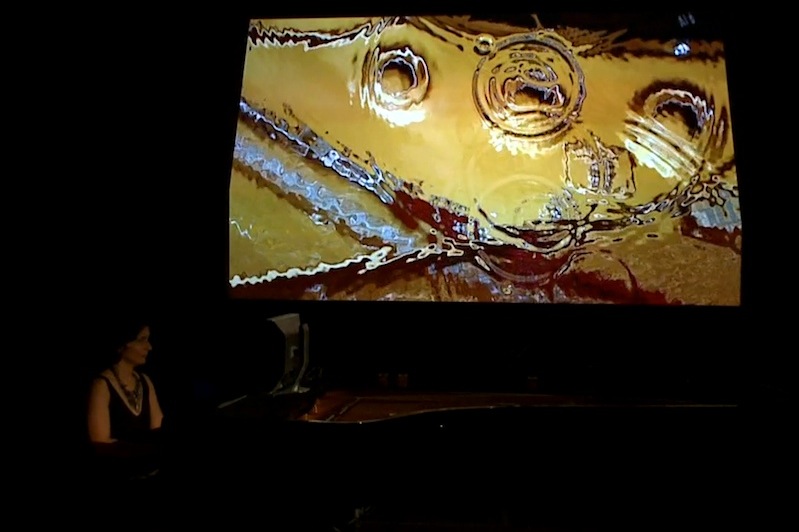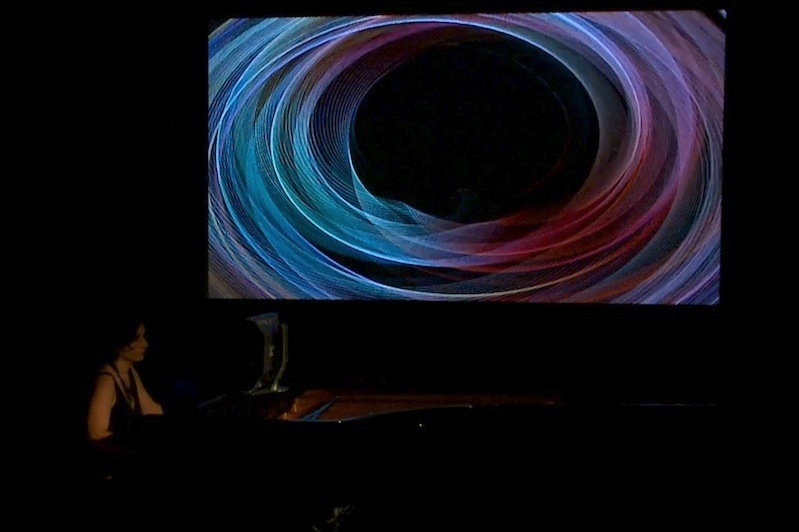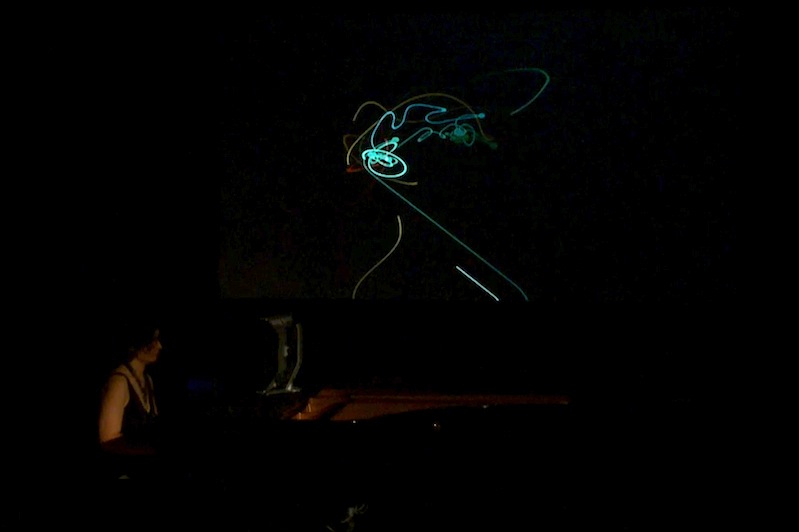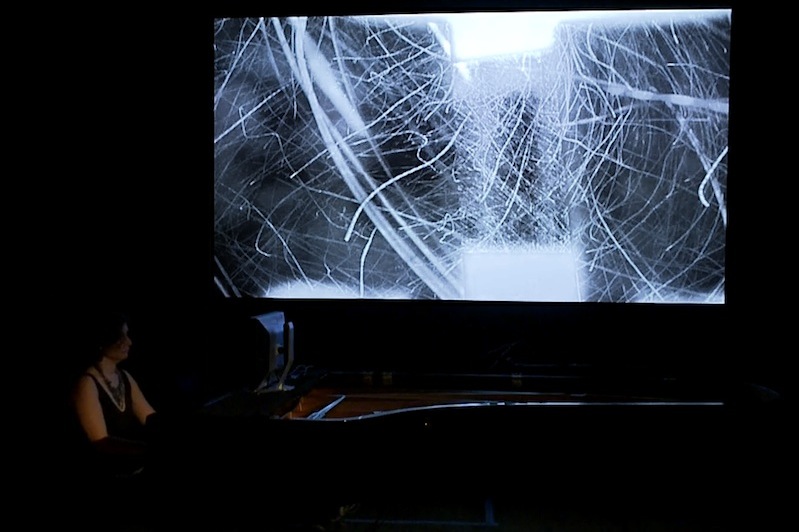Rokeby : Home
/ Works / Current
Shows / Texts / softVNS
/ Links / e-mail
me
Interactive Installations : Surface Tension (collaboration with Eve Egoyan)
(2009)
Commissioned for the Open Ears Festival

Eve Egoyan Performing the first movement of Surface Tension at CIRMMT, McGill University (2010)
Surface Tension is a collaborative work for disklavier piano and interactive video commissioned by the Open Ears Festival through the Canada Council. It was premiered at Open Ears in Kitchener in 2009. It was recently presented at the 2010 Sound Symposium in St. Johns, Newfoundland, at McGill University in Montral, Canada and at the Sound Arts Research Centre in Belfast, UK.
In Surface Tension, Eve's performance at the keyboard of a disklavier (an acoustic piano with a computer interface) is transformed and interpreted by a computer into live visual images projected onto a screen rising from the body of the piano. The visuals respond to a variety of performance parameters including dynamics, pitch, the harmonic relation between pitches, the use of the sustain pedal, and the duration of individual notes.
Much of the visual material is based on simulations of natural processes such as the swarming behaviours of insects, the trajectories of planets or the rippling of water when a pebble hits the surface. Eve's performance triggers and modulates aspects of these simulations; the visual representations respond to Eve, but also have a sort of life of their own, becoming in a sense a partner in the performance. In one movement, each note played on the piano contributes to the construction of a three-dimensional tower. In another, Eve draws out the trajectories of falling snowflakes, manipulating the live processing of a pre-recorded video. Yet another charts the harmonic relationships between the notes that Eve is playing.
The performance itself is a loosely structured audio-visual improvisation in 5 movements. The improvisation is shaped partly by Eve's response to the system's visual response to her playing. All visual activity on the screen is directly responsive to Eve. The result is an extraordinary integration of sound and image in which neither of these elements dominate the other.
Movement 1: The Pool
The interior of a piano is seen in the projection as though reflected in a still pool of water. Each note that Eve plays is like a pebble dropped into the pool, sending ripples flowing outward, disturbing the image. Loud notes are like larger stones, producing a larger disruption. When the pianoÕs sustain pedal is down, the ripples continue to unfold without diminishing over time. The waves echo off the edges of the pool, layering and layering in a way that reflects the reverberations of the pianoÕs sound in the hall. When the pedal is up (and the piano sound is drier), the ripples dissolve quickly and most of the surface of the pool stays flat and mirror-like.

Movement 2: Harmonic Orbits
In this movement, the projection represents the harmonic relationship between the notes that are currently sounding on the piano. A single note forms a circle of a size determined by the loudness of the note, which decays at a similar rate to the decay of that noteÕs sound. (Low notes naturally decay more slowly than high notes). When two notes are played at the same time, the relationship between the notes produces more complicated shapes that reflect the relative harmonic consonance or dissonance between the notes. Strongly harmonic combinations like 4ths and 5ths produce simple looping curves. As more notes are played and their harmonic relationships get more complicated, the shape reflects this greater complexity in increasingly complicated forms, achieving a cloud-like blur at extremes of dissonance.
A loudly played, slowly decaying bass note can be delicately modulated by softly played and quickly decaying notes in the upper register. Loud octaves produce what looks like a collapsing solar eclipse. The projection reflects the passage between consonance and dissonance of EveÕs improvisation.

Movement 3: The Tower
In this movement, each note that Eve plays adds a new element to a three-dimensionally rendered tower. Notes of the octave are represented by 12 positions around the central spine of the tower. Louder notes push out further from the centre and quieter notes cluster close to the spine. Staccato notes produce sharp points, and held notes draw these points along the spine into longer surfaces. As Eve plays, she adds new structures to the top of the slowly descending tower, building and sculpting with her touch at the piano keyboard. The tower is repeated twice in the distance of the image to provide a sense of the construction over larger periods of time.
A chromatic scale produces a spiral around the spine. Repeated notes and patterns produce repetitive visual structures. Sudden loud chords produce large platforms and quiet passages produce undulating geometric columns.

Movement 4: Tendrils
In this movement, Eve's notes interact with each other in a manner that reflects the ways planets are affected by each otherÕs gravity and how insects, birds and fish swarm, flock and school. When played, a note rises visually from the piano, with the low notes on the left and high notes on the right. The note trajectories are coloured based on their pitch with lowest notes on the piano being red, the middle section rising through orange, yellow, green and blue, and with the highest notes being purple.
Once released by EveÕs finger pressing on the keyboard, each note shoots around the screen attracted to previously played notes that it is in relative harmony with and ignoring notes with which there is a more dissonant relationship. As this dance of attractions evolves, the trajectories take on rich, complex and organic forms, just as the sounds of the notes released into the air shimmer and throb in their harmonic relations.

Movement 5: Flurry
The base of the visual aspect of this movement is a video recording of snow falling in downtown Toronto. The image has been processed to blur the architecture, and leave the snowflakes in focus. When Eve is not playing, the snow is not visible. Staccato notes reveal the snow for an instant. In rising sequences of notes, time flows forward, and in descending sequences, time flows backward. Held notes keep the flakes visible until the note is released. The brightness and visibility of the flakes is related to how many keys Eve is currently holding down. Trills hold time suspended. The occasional passerby or bicyclist in the video can be held in limbo as Eve plays time up and down the keyboard.
The sustain pedal, when pressed, holds onto the history of the flakes, drawing them out into trajectories. By pressing down many keys and holding the sustain pedal down, Eve can create a blinding white-out.
This project was commissioned with assistance from the Canada Council for the Arts and further development has been made possible by the Integrated Arts Program at the Ontario Arts Council.
Selections from a performance at McGill in Montreal, 2010
History
2009
Open Ears Festival, Kitchener, Canada
2010
Sound Symposium, St. Johns, Canada
CIRMMT, McGill University, Montreal, Canada
Sonic Arts Research Centre, Queen's University, Belfast, U.K.
2011
"What's Next" Festival, Hamilton Philharmic Orchestra / Art Gallery of Hamilton
"ArtSmart" “Art, Science and the Brain” MaRS, Toronto
Nuit Blanche 2011, Centre culturel canadien, Paris, France
Philip T Young Recital Hall, University of Victoria, Victoria, BC
Rokeby : Home / Works
/ Current Shows / Texts
/ softVNS / Links
/ e-mail me
Copyright 2010 David
Rokeby / very nervous systems / All rights reserved. 11/25/2010





